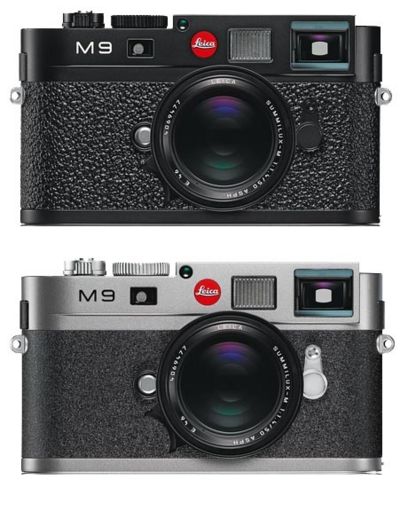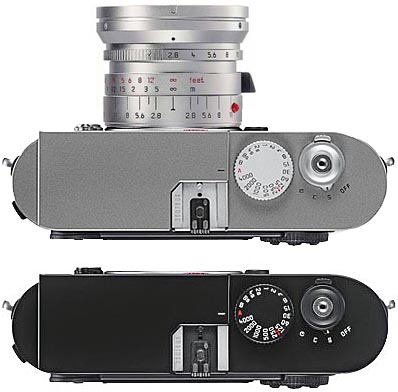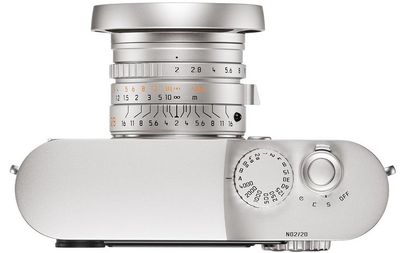M9: Difference between revisions
From Leica Wiki (English)
Jump to navigationJump to search
| Line 64: | Line 64: | ||
**'''Limited edition''' - 500 cameras with titanium [[35mm f/1.4 ASPH.2 Summilux-M]] | **'''Limited edition''' - 500 cameras with titanium [[35mm f/1.4 ASPH.2 Summilux-M]] | ||
**'''Materials''' - Titanium body, Nappa leather jacket & sapphire-crystal monitor | **'''Materials''' - Titanium body, Nappa leather jacket & sapphire-crystal monitor | ||
**'''Carrier belt''' - for camera or binoculars - designed by [[Stefan Daniel]] and [[Oliver Zielberg]] Sep 7, 2010 | |||
Oliver Zielberg | |||
*'''Reviews''' | *'''Reviews''' | ||
**[http://www.classicdriver.com/uk/magazine/3800.asp?id=14788 Classic Driver] | **[http://www.classicdriver.com/uk/magazine/3800.asp?id=14788 Classic Driver] | ||
Revision as of 18:07, 17 January 2013
Manufacturer's Technical Data LEICA M9 - 09 Sep 09
- Production era - Sep 2009-Jul 2012 - (M9-P 2011-Aug 2012)
- Order-No. - 10 705 (steel-gray paint) - 107 04 (black paint) - 107 15 (titanium) - 10 716 (M9-P silver chrome) - 10 703 (M9-P black paint)
- Camera type - Compact digital rangefinder system camera.
- Lens mount - Leica M bayonet with additional sensor for 6-bit coding.
- Lens system - Leica M lenses from 16 to135 mm.
- Image format / image sensor - 5270 × 3516 pixels (18.5 megapixels) CCD chip, active area approx. 23.9 × 35.8 mm / 5212 x 3472 pixels (18 megapixels) (corresponds to the effective image format of Leica M film cameras).
- Optional resolution - DNG™ - 5212 × 3472 (18 MP), JPEG: 5212 × 3472 (18 MP), 3840 × 2592 (10 MP), 2592 ×1728 (4.5 MP), 1728 ×1152 (2 MP), 1280 x 846 pixels (1 MP).
- Image file formats - DNG™ (RAW data), optionally uncompressed or slightly compressed (by non-linear reduction of color depth), 2 JPEG compression levels.
- File sizes - DNG™: 18 MB (compressed) 36 MB (uncompressed) JPEG approx. 2 to10 MB, (depending on image content)
- Color spaces - Adobe® RGB, sRGB.
- White balance - Automatic, manual, 7 presets, direct color temperature selection.
- Storage media - SD cards up to 2 GB / SDHC cards up to 32 GB.
- Menu languages - German, English, French, Spanish, Italian, Japanese, traditional Chinese, simplified Chinese, Russian.
- Compatibility - Windows® XP/Vista®; Mac® OS X (10.5)
- Exposure metering - Through-the-lens (TTL) metering, center-weighted at working aperture. Center-weighted TTL metering for flash exposure with dedicated SCA-3000/2 standard flash units.
- Metering principle - The light reflected from the bright leaves of the first shutter curtain is metered.
- Metering range (at ISO 160/23°) - At room temperature and normal humidity, equivalent to EV 0 to 20 or f 1.0 and 1.2s to f 32 and 1/1000 s. Flashing left triangular LED in the viewfinder indicates light levels below metering capability.
- Metering cell - for available light (ambient light metering) Silicon photodiode with condenser lens, bottom center of camera base.
- Sensitivity range - ISO 80/19° to ISO 2500/35°, selectable in 1/3 ISO increments, in aperture priority automatic mode A and manual exposure setting, optional automatic control or manual selection, automatic control in snapshot mode.
- Exposure modes - Optional automatic determination of shutter speeds with preselected apertures – aperture priority automatic mode A – with corresponding digital display, or manual selection of shutter speed and aperture and balance by means of an LED light balance with correct exposure display, or over exposure / camera shake trend prevention (snapshot mode only).
- Flash connection - Hot shoe with center and control contacts.
- Synchronization - Optional, on first or second curtain.
- Flash synchronization speed - 1/180 s; longer shutter speeds may be used.
- Flash metering - (With SCA-3501/3502 adapter or SCA-3000-standard flash unit, e.g. LEICA SF 24D / LEICA SF-58 Flash exposure control with center-weighted TTL pre-flash metering.
- Flash metering cell - 2 silicon photodiodes with condenser lens in camera base.
- Flash exposure correction - ±3 1/3 EV in 1/3 EV increments, adjustable on SCA-3501/3502 adapter.
- Settings in computer mode for LEICA SF 24D, ±3 EV in 1/3 EV increments, or from 0 to –3 EV in 1 EV increments / adjustable in all modes for LEICA SF 58, ±3 EV in 1/3 EV increments.
- Displays in flash mode - Flash ready: constant illumination of flash symbol LED in the viewfinder, flash confirmation: Constant illumination or rapid flashing of the LED after exposure, underexposure indicated by temporarily extinguished LED.
- Viewfinder principle - Large size, bright, combined bright-line viewfinder / rangefinder with automatic parallax compensation.
- Eyepiece Adjusted to -0.5 diopters Correction lenses for –3 to +3 diopter available.
- Image field framing - By projection of two bright-line frame with each lens attached: for 35 and 135 mm, or for 28 and 90 mm, or 50 and 75 mm. Automatically displayed when lens mount locks. Any of the pairs of bright-line frames can be displayed by moving the frame selection lever.
- Parallax compensation - The horizontal and vertical differences between the viewfinder and the lens are automatically compensated in accordance with the focusing distance set, i.e. the bright-line frame of the viewfinder automatically moves to cover the image field covered by the respective lens.
- Correspondence between the viewfinder and the actual image - At a focusing distance of 1 meter, the bright-line frame size corresponds precisely to that of a sensor of 23.9 × 35.8 mm. Focused at infinity, and depending on the focal length, approx. 7.3% (28 mm) to 18 % (135 mm) more of the sensor is covered than the bright-line frame actually shows, the opposite is the case for focusing distances less than 1 meter, i.e. somewhat less.
- Viewfinder magnification(for all lenses) 0.68×
- Long-base rangefinder - Bright rectangular spot (RF spot) with coincident and superimposed rangefinder in the center of the viewfinder. Effective rangefinder base 47.1 mm (actual base length 69.25 mm × viewfinder magnification 0.68×).
- Viewfinder displays - (Lower edge) LED symbol for flash status. Four-digit, seven-segment digital LED display with dots above and below, display brightness adjusted for ambient light, for exposure correction warnings, display of automatically determined shutter speed in aperture priority automatic mode, exposure value lock indicator, out of metering range warning in aperture priority automatic mode and countdown display for shutter speeds longer than 2 s. LED light balance with two triangular and one round, central LED in manual exposure mode. The triangular LEDs show the required directions for turning the aperture ring or the shutter speed dial to correct the exposure setting. They also warn of light levels that are above or below the metering range.
- Displays on the back - 2.5" monitor (color TFT-LCD) with 230,000 pixels
- Shutter - Microprocessor-controlled, particularly low-noise, metal-leaf, vertical focal-plane shutter.
- Shutter speeds - In aperture priority automatic mode (A) continuous from 32 s to 1/4000 s. in manual mode, 8 s to 1/4000 s in half increments, B for arbitrary long exposure times (in conjunction with delayed release T function, i.e. 1st release = shutter opens, 2nd release = shutter closes, (1/180 s) fastest shutter speed for flash synchronization. Shutter cocking With integrated motor, with low-noise footprint, optionally only after release of shutter release button.
- Continuous shooting - Approx. 2 frames/s, ≥ 8 frames in sequence.
- Shutter release - Three steps: activation of metering – store metering values (in aperture priority automatic mode) – shutter release. Standard internal threading for remote release.
- Delayed release - Countdown 2 s (in aperture priority automatic mode and manual exposure mode) or 12 s, menu setting option, countdown is indicated by a flashing LED on the front of the camera and a corresponding display on the monitor screen.
- Camera power on / power off - Main switch located on the top deck, optional sleep mode for camera electronics after 2 / 5 / 10 minutes, reactivation by slight pressure to shutter release button.
- Power supply - 1 rechargeable lithium-ion battery, nominal voltage 3.7 V, capacity 1900 mAh. Charge level displayed on monitor screen, when shutter locked in open position (for sensor cleaning), additional acoustic warning signal for insufficient charge.
- Battery charger - Inputs: 100–240 V AC , 50/60 Hz, automatic adaptation, or 12/24 V DC - Output: 4.2 V DC, 800 mA.
- Camera body - Full-metal body in diecast magnesium alloy with cataphoretic paint finish and artificial leather trim. Brass top deck and base plate, black or steel-gray finish.
- Frame selection lever - Enables the manual display of different bright-line frame pairs at any time (e.g. for framing comparisons).
- Tripod thread - A 1/4 (1/4 “) DIN, stainless steel, integrated in base plate.
- Operating conditions - 0 to +40°C
- Interface - 5-pin Mini-USB 2.0 high-speed socket for fast data transfer.
- Dimensions (length × depth × height) - Approx. 139 × 37 × 80 mm; 5.47 x 1.46 x 3.15 in
- Weight - 585 g (including battery) / 1.30 lb
- Package includes - Battery charger 100–240 V (14470) with two power cords (Euro, USA, may differ for other export markets) and one car charging cable, lithium-ion battery, USB cable, carrying strap.
- Accessories - Steel-gray handgrip 14490 - Black-paint handgrip 14486
Special Editions
- Titanium version introduced September 2010 - Designed by Walter de'Silva
- Limited edition - 500 cameras with titanium 35mm f/1.4 ASPH.2 Summilux-M
- Materials - Titanium body, Nappa leather jacket & sapphire-crystal monitor
- Carrier belt - for camera or binoculars - designed by Stefan Daniel and Oliver Zielberg Sep 7, 2010
Oliver Zielberg
- Reviews
- Video - M9 Titan
- M9-P introduced June /July 2011
- Limited edition - 100 cameras in hammertone - also available in black & chrome (20 cameras)
- Materials - Vulcanite jacket & sapphire-crystal monitor
- Reviews
- Edition Hermès - June 2012 - 300 sets w/ 1 lens - 100 sets w/ 3 lens (On-the-street EUR 55,000 - 2012)
- Materials - Ocre calfskin leather jacket + silver-anodized lenses
- Video - Vemio Hermès
- Forum discussion
Comment
- On the street - $US 6,499 in 2012 (M9) - $US 7,699 in 2012 (M9-P)
- Forum discussion
- Reviews
- Test shots & Tutorials
- Manuals & brochures
M9 Lenses
M9 Accessories
M9 Firmware History
(see Leica Owner's area for current updates)
- 1.002 - September 9, 2009
- Initial Version
- 1.116 - March 15, 2010
- Camera Performance
- Faster zooming into the last picture taken
- Speed of SD-card formatting enhanced
- Image quality of “thumbnail” pictures improved
- SD- Card compatibility improved
- Magenta colour shift correction for the following wide angle lenses improved
- New ISO setting-related vignetting correction
- Bug fixes
- Transfer of large data amounts to a Mac in USB-Mass storage mode
- Sensor cleaning mode with battery capacity <50%
- Function “Deleting all images” while zoomed picture is shown on screen
- Function “Deleting all images” from a SD card with non-M9 pictures on it
- Interrupting a long exposure by switching off the camera
- Zooming into pictures with “Vintage B+W” setting
- “Max aperture value” in EXIF data corrected for the following lenses
- SDHC card compatibility
- Camera Performance
- 1.138 - August 6, 2010
- Improved compatibility of SDHC cards. Nevertheless, we recommend our customers cards such as the “Extreme III” from the leading brand “SanDisk”.
- Improved Auto White Balance in conditions with power saving lamps and tungsten light.
- Saving user profiles has been improved (changing from one profile to another did sometimes cause problems)
- Time display in “American” format corrected.
- Auto power off bug fixed (camera did turn off automatically while using the Play Mode or scrolling through the menu).
- 1.162 - June 15, 2011
- 1. Camera Performance:
- Improvement of the sensor homogeneity for wide-angle lenses. There is an additional colour calibration for all wide-angle lenses, that minimizes chromatic deviations between image centre and image corner, especially in critical shooting situations.
- Optimization of internal processes. To assure the general system stability, internal software processes have been optimized.
- 2. Bug fixes:
- Improvements in Italian translations
- 1. Camera Performance:
- 1.174 - November 8, 2011
- Leica Camera has become aware of customers experiencing compatibility issues related to select types of new memory cards when used in the Leica M9. This Firmware 1.174 fixes a bug that led to the faulty behavior. Generally Leica recommends to use SD / SDHC Cards from San Disk. Until further notice, the following SD-Cards are still not recommended to use, because some misbehavior occurred in the test phases.
- San Disk Extreme Pro SDHC I UHS-1 (all card sizes)
- San Disk Extreme HD Video SDHC I (all card sizes)
- Leica Camera has become aware of customers experiencing compatibility issues related to select types of new memory cards when used in the Leica M9. This Firmware 1.174 fixes a bug that led to the faulty behavior. Generally Leica recommends to use SD / SDHC Cards from San Disk. Until further notice, the following SD-Cards are still not recommended to use, because some misbehavior occurred in the test phases.
- 1.176 - December 6, 2011
- All cards available from SanDisk have been compatibility-tested and the firmware version 1.1.76 ensures their proper function.
- 1.196 - July 23, 2012
- Further improvements of SD card compatibility.
- Implementation of the lens detection of the new APO-Summicron-M 1:2/50mm ASPH.
- Improved power management.
M9 Serial Numbers
Serial numbers compiled from known M9 cameras| SN Start | SN End | Product | Year | Total |
|---|---|---|---|---|
| 34842275 | 3809531- | M9 (black+grey) | 2009 | 6,031+ |
| 3809781 | 3810825- | M9 (black+grey) | 2009 | unknown |
| -38101XX | 38114XX- | M9 (black) | 2009 | unknown |
| -3834495 | 3842870- | M9 (black+grey) | 2010 | unknown |
| -39045XX | 3976573- | M9 (black+grey) | 2011 | unknown |
| -unknown | 4201448- | M9 (black+grey) | 2011 | unknown |
| TOTAL | ASSIGNED | SERIAL NUMBERS | 2009-2012 | unknown |
M9-P Serial Numbers
Serial numbers compiled from known M9-P cameras| SN Start | SN End | Product | Year | Total |
|---|---|---|---|---|
| 42009XX | 42032X- | M9-P (silver) | 2011 | unknown |
| -4205157 | 4230778- | M9-P (black) | 2012 | 25,622+ |
| -4339749 | unknown- | M9-P (silver) | 2012 | unknown |
| TOTAL | ASSIGNED | SERIAL NUMBERS | 2011-2012 | unknown |





